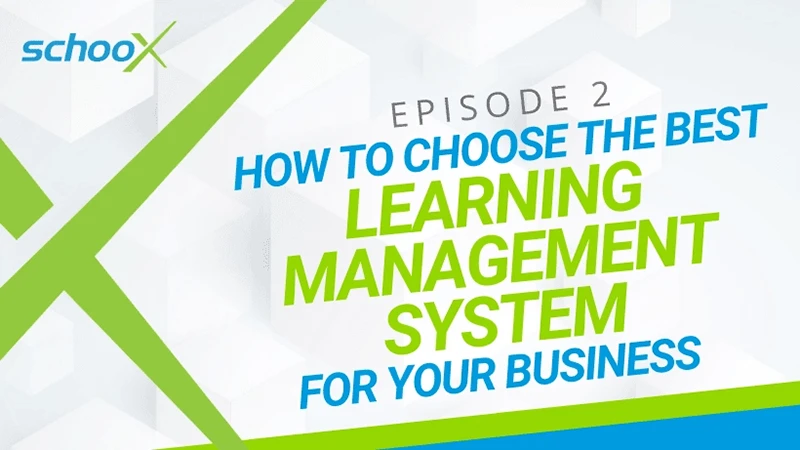October 15, 2020
9 Min. Read

Need help choosing the best learning management system (LMS) for your business? There are many important factors to consider when selecting an LMS, and you must choose one that meets your business’s needs.
In this episode of The Learning Xchange, our host Matthew Brown (VP of Learning and Brand Success at Schoox) explores the challenges that many of you face when selecting and implementing an LMS. You’ll learn what to look out for when choosing a learning management system so that you can make a confident decision that is right for your business.
Listen to this episode of the podcast below:
Or, keep reading to learn more about choosing the best LMS.
Why you should take your time when choosing a learning management system
Learning management systems can be expensive. If you want to get the most ROI for your money, select an LMS that you and your team will use. Many businesses invest in an LMS that they rarely use. They might use it for training new hires or return to it a few times throughout the year. Either way, they are not getting real value from their investment. So, why are businesses purchasing systems that they barely use?
The answer lies in the decision-making process that the business went through before purchasing the system. Perhaps the company faced a problem, and they needed a solution as fast as possible. Or, maybe the business was up against a tight deadline to replace a different system. Whatever the case, the business rushed through the decision-making process and failed to take the time to research learning management systems before purchasing.
Choosing an LMS too fast increases the risk of missing out on some critical details about the LMS. It could be too slow or inadequate at meeting the business’ objectives and needs.
When it comes to selecting an LMS, think about it in the same way you make personal buying decisions. You wouldn’t buy a car without giving it a test drive first. You also wouldn’t buy a house without making sure it’s a perfect fit for your family. So, why would you choose an LMS without ensuring that it is right for your business?
Clarify all of the needs and requirements that the LMS must meet before you can implement it into your business. Don’t be fooled by empty marketing messages promising you incredible results without doing your research and making sure those promises are kept. Ensure that the LMS you choose meets your specific needs. Remember, not all learning management systems are created equal. Some are much better than others, and you need to ensure that you choose the best LMS for your business.
Create a plan
When you find yourself at the start of the buying journey for a new LMS, your number one priority is to choose a system that meets your needs. Not only your needs for today but tomorrow and beyond. It would help if you also choose an LMS that everybody can benefit from.
When making any important purchasing decision, the first step is to make an extensive plan that focuses on requirements. Create a list that includes all of the requirements that you want the new LMS to fulfill. Once you have the list, go through it strategically, and prioritize the requirements according to which ones are critical. Those are the requirements that your business cannot live without. As you go further down the list, you’ll reach the requirements that would be nice to have, but you can find a way to live without them.
You can have some fun with the planning stage of the buying process and create a wish list. Include things that you hope to aspire to in the future you would love to find in an LMS. You can prioritize the wish list to include which things you want sooner rather than later and which things might have to wait a while.
Consider the audience
While you’re still in the planning stage, remember to consider the audience. The end-user of the LMS will be the learner or the employee. Understand the needs of the end-user and consider the technical capabilities of each user. If you have people in the business who are not as tech-savvy as others, think about how you can make engaging with the system easier for them.
On the other hand, the tech wizards in your team will want to pick apart every detail about the learning management system. You’ll also need to make sure that their needs are met, too. It’s important to remember that people learn in different ways. While building your training, think about whether different learners can use the system accordingly. Understand your audience and how the system fits their various needs.
Identify business objectives
Get specific about your business needs. What is the business striving to accomplish? Is the company on a mission to scale and grow? Does the business want to diversify the services and products on offer?
You need to know the answer to all of these questions and more. If you are not aware of the answers, you will have a hard time choosing the right learning management system because you are not considering whether the LMS will help accomplish business objectives. Worst case scenario – you’re left with a mediocre system that is very rigid, creates a lot of issues, and fails to help you achieve your objectives.
Consider current pains
Understanding the current pains of your business is crucial when choosing the best learning management system. What is the business experiencing as a pain? What are the different departments within the business experiencing? Once you clarify these pain points, you can strive to find an LMS that addresses them appropriately.
Let’s assume that you want to decrease turnover and focus on employee engagement. Therefore, you should look for an LMS that has features that employees can engage with. You also need to understand the vision of the company. Where is the business headed? Consider the vision and pain points when selecting an LMS.
Build a broad stakeholder community
Who are your stakeholders? Although they might not be key members of the training team, stakeholders still need to be involved with the planning part of the decision-making process. You should ask for their feedback and for their help to evaluate different learning management systems.
If you have an entire population of computer users, it will be much easier for them to access the learning management system. However, if you have a distributed workforce (such as a retail store or a restaurant), not everyone will have access to computers. In cases like that, you must clarify your company’s stance on team members using their own devices to access the LMS. Take time to document all of these things so that you can consider it closely during the decision-making process.
The research and selection process
After the planning stage, you’ll reach the research and selection process. This involves going through many different learning management systems on the market and figuring out which one is right for your business. When considering an LMS, you need to look beyond the type of technology on offer.
Although the learning team is responsible for managing, administering, and keeping the LMS functioning, they are not the only team within the company that will use the LMS. Therefore, the LMS must meet the needs of the entire business. The stakeholders who help you make this important decision should bring a different perspective and help you make the right choice. When choosing the best LMS, the last thing you need is a bunch of “yes” people.
The implementation process
When you have landed on the right learning management system, you are ready to implement that system into your business. Hopefully, people are actually using the system beyond regularly. To make the implementation process a success, it’s a good idea to set small, achievable goals. An example of an attainable goal would be having 50% of people log-in to the LMS in the first 30 days.
Change management is very important and should be a key part of your implementation journey. The problem is that many businesses struggle to build a robust chain management strategy.
So, what goes into an effective change management approach?
- Know your audience
- Create use cases and scenarios – and then test them out!
- Understand the business objectives
- Clarify how the LMS can contribute to your success in achieving those objectives
- Identify your pain points
- Build a committee to help you make the purchasing decision
- Get a cross-functional team
All of these things will help ensure that you create an effective change management approach and that the implementation of the LMS you have chosen is successful.
How to increase LMS usage
Getting people to actually use the LMS can be a difficult task, but there are ways that you can make the LMS more engaging. If your system offers document distribution, that’s a great way to get more people using the LMS. Think about including documents such as company policies and guidelines that can live in your LMS. That way, when people need to access those documents, they have to log-in to the LMS.
An LMS with a social component will attract more usage. If people can interact and engage with each other on the LMS, that gives them a reason to keep coming back to the system. You could even consider moving things like performance reviews and goal setting trackers to the system. Think outside the box when trying to increase early adoption and don’t be afraid to get creative and get other people involved.
Consider the vendor
Many businesses solely focus on the learning management system itself and rarely consider the people behind the technology. Pay close attention to the experiences you have with the people behind the LMS. Perhaps you talked to a salesperson. If so, what was that experience like? Did they answer your questions? If you ran into an issue and contacted support, did they help you to resolve the issue?
Your needs are important. Always want to make sure that you are in a partner relationship, not a one-sided vendor relationship. Don’t choose an LMS without considering the vendor. Choosing the best LMS for your business is about more than choosing the latest technology or a popular brand that everyone seems to be talking about.
Choose your learning management system carefully
In conclusion, choosing the right LMS for your business involves a lot of planning, research and second opinions. When you are actively searching for a new learning management system, be diligent. Take your time and make sure that your organization understands why this is such an important decision. Get a broad perspective and seek opinions from others as much as possible. Remember that everyone in the business has to use this system, so make sure that you choose an LMS that speaks to everyone.
Do you want to learn more about choosing the best learning management system? Check out our free eBook, “Your Guide For Choosing The Best Learning Management System.”


